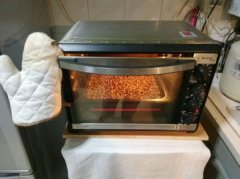Changes in coffee roasting knowledge of shallow roasting coffee
Coffee always gives people a black and bitter stereotype, but in fact, it is like a fruit, sour and sweet. The diversity and variation of the flavor of the lightly roasted manor-grade boutique coffee is no less than that of red wine. You can feel rich fruit, flower and sweet aromas in a good cup of coffee noodles. After trying it, you will definitely gradually like this wonderful taste.

The coffee beans we use to brew coffee are actually seeds hidden in bright red coffee berry noodles. The ripe pulp tastes a bit like grapes with thinner skins and is very sweet. When a farmer plucks it from a tree, it must go through a process of pulp removal, fermentation, washing or sun treatment, and then drying before the so-called raw coffee beans. Fresh green coffee beans can not be eaten directly, but must be roasted in the machine to remove moisture, which is a common coffee bean.
In the process of roasting at high temperature, raw coffee beans will gradually lose moisture, and the color will change from turquoise to brown, while the Mena chemical reaction will produce aromatic substances, oils and caramelization. Like popcorn, coffee beans burst their cell walls twice during roasting, the first at about 190 ℃ and the second at about 215 ℃. The whole volume increases with popping, but the organic acids disappear as the temperature increases. If the temperature continues to rise above 220 ℃, the sugar will gradually be carbonized, the sour taste will disappear completely, and the bitter taste will occur.
After knowing the roasting principle of coffee beans, it is easy to distinguish the degree of roasting, which can be judged by the following:
Appearance: shallow baking-many wrinkles on the surface, deep baking-smooth surface.
Color: light baking-light color, deep baking-dark color.
Taste: shallow baking-sweet and sour, deep baking-bitter fragrance.
Preservation: shallow baking-oil production speed is slow, deep baking-oil production speed is fast.
At present, it is generally believed that the shallow roasted coffee is between the first burst and the first burst, which is commonly known as cinnamon roasting (Cinnamon Roast). This roasting method can retain more of the original coffee flavor, such as sour, aroma, sweetness and other pleasant taste, so it is also tested in international coffee cups with a similar roasting degree.
Roasting coffee beans is not magic, raw bean noodles do not have things, can not be roasted out of it. In the past, under the influence of trader orientation, with the exception of the Blue Mountains of Jamaica and Kona, Hawaii, affordable commercial raw beans flooded the market, and coffee roasters had less access to high-quality coffee raw beans, so the main direction of baking methods is to remove defects. In contrast, today's own roasters are quite happy. It is easy to obtain high-quality coffee beans in line with international standards, and the roasting method has changed to retain the original good taste, thus improving the recognition of different places of origin.
Because of this concept of shallow baking, more and more cafes offer such products, and consumers' acceptance is also increasing.
Important Notice :
前街咖啡 FrontStreet Coffee has moved to new addredd:
FrontStreet Coffee Address: 315,Donghua East Road,GuangZhou
Tel:020 38364473
- Prev

Etiquette knowledge of coffee etiquette that must be known when drinking coffee
Didi is fragrant and full of meaning. Human beings have been drinking coffee for at least 500 years, and it has become a necessity for westerners' life. When dealing with Westerners, there are often occasions to drink coffee together, so coffee etiquette is indispensable. Drinking coffee can be made from self-ground coffee beans and boiled in a coffee pot, or you can drink instant coffee directly with boiling water. One abroad
- Next

Coffee roasting knowledge teaches you to bake coffee in a household oven
Before baking, pick out the residual beans (insect beans, fermented beans, shell beans, etc.).) Heat the upper and lower tubes of the oven, preheat 150℃, put the raw beans in the selection cage, put them in the oven, change to the upper tube heating, rotate mode, 150℃, bake for 10 minutes, raise the temperature to 230℃, bake for about 25 minutes (depending on the individual's need for baking, you can adjust the time flexibly) to remove the cage.
Related
- Beginners will see the "Coffee pull flower" guide!
- What is the difference between ice blog purified milk and ordinary milk coffee?
- Why is the Philippines the largest producer of crops in Liberia?
- For coffee extraction, should the fine powder be retained?
- How does extracted espresso fill pressed powder? How much strength does it take to press the powder?
- How to make jasmine cold extract coffee? Is the jasmine + latte good?
- Will this little toy really make the coffee taste better? How does Lily Drip affect coffee extraction?
- Will the action of slapping the filter cup also affect coffee extraction?
- What's the difference between powder-to-water ratio and powder-to-liquid ratio?
- What is the Ethiopian local species? What does it have to do with Heirloom native species?

